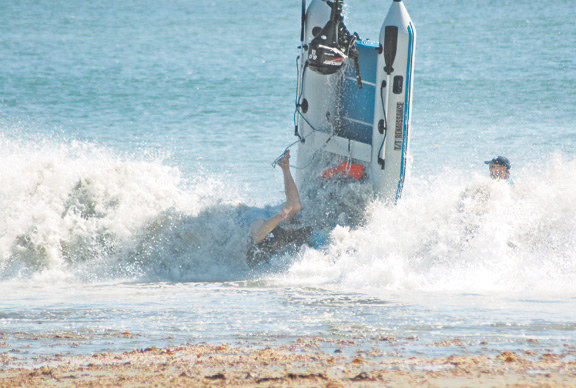
Avoiding Dinghy Disasters

© Latitude 38 Media, LLC
With the start of another cruising season, we’ll remind readers that dinghy landings can be extremely dangerous. If you’re not careful, you could be injured or even killed, as an outboard prop can rip right through flesh. Here are some guidelines to follow.
When going ashore:
1) Always wear a lifejacket.
2) Always wear the engine kill switch on your wrist so the prop will stop if you flip.
3) Don’t become a sitting duck for waves by overloading your dinghy. Two fast trips are dryer than one short one.
4) Pick your landing site carefully, as some spots are usually calmer than others.
5) Be patient. You might have to wait five minutes or more to find a good lull. Most flips and dunkings occur because people weren’t patient.
6) Sometimes the surf is too big or the waves are too hollow for a safe landing. Wait until it’s safe.
7) If you’ve never taken a dinghy through the surf before, watch the technique of experienced people first, or take a panga to the beach.
8) Ride in on the back — not the crest — of a wave, then go like hell. As soon as it’s shallow enough for you and your crew to hop out, kill the engine, jump out, and charge to shore. Speed is the key to success.
9) If you ever get sideways to a wave, kill the engine immediately! Chances are you’re going to flip.
10) If a wave overtakes you from behind, kill the engine immediately! Chances are you’re going to flip.
11) Never stand between the dinghy and shore. If a wave slaps into the dinghy, it will knock you on your ass and be washed right over you.
When going back out:
1) Going out is even harder than coming ashore, because you’re going into the waves rather than with them, and because you’ll have much less time between waves.
2) Follow all safety instructions as for ‘Going Ashore’.
3) While in knee-deep water, be prepared, with entire crew instantly ready to jump in, outboard all ready to fire up, and the kill switch on your wrist. Never stand between your dinghy and the shore, you’ll get knocked on your ass.
4) Be patient! It’s even more important to get a great lull when going out than coming in.
5) As soon as the soup from the last wave before the lull has gone by you, go like hell until thigh-deep water, have everyone jump in instantly, fire up that engine, and go! You should look like a commando team.
5) Most folks get drenched because they overload their dinghies or take forever to get their crew in and get the engine started. You have less than 10 seconds if you’re going to be going through a breaking wave. It’s all about speed, speed and more speed.
6) Always head directly through the wave, never diagonally.
7) No matter what happens, never let your occupied dinghy get sideways to a breaking wave. You’ll surely roll, and people will get hurt. If you see that this will be unavoidable, always be ready to kill the engine before you lose complete control.
8) If it’s obvious that you’re not going to make it through a big wave, kill the engine, and have everyone get as far away from the dinghy as possible — instantly. Speed is of the essence.
9) Just because you made it over one swell doesn’t mean the next one won’t get you. Go! Go! Go! until you’re in deep water.
10) Sometimes you’ll have to walk your dinghy out until you’re nearly chest-high in water to make it through the waves. Sometimes you simply can’t make it out. In those cases during the Ha-Ha, we take a panga taxi instead.
Please be safe out there!
